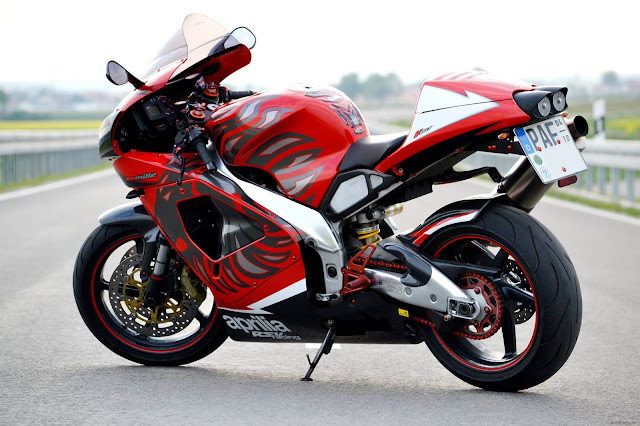Aprilia RSV 1000R
With its rigid and compact chassis benefiting from high-quality parts from Ohlins and Brembo, the RSV Factory handled and stopped brilliantly.
The new-gene rat ion RSV was a more sleek and integrated machine than its rather ungainly predecessor, but not quite such a distinctive one.
Aprilia's second-generation RSVIOOOR had a lot to live up to. The original RSV Mille had been launched in 1998, catapulting the Italian firm into the superbike market after decades of building and racing smaller machines. Since then more than 25.000 Milles had been sold, and the Aprilia had also been reasonably successful on the racetrack, winning races if not the title in World Superbikes.
Five years after that spectacular arrival came the RSV’s first major redesign. Both engine and chassis were overhauled, as well as the Aprilia’s look. The old model was a tall bike, and despite all its engineering excellence had never been regarded as particularly stylish. In contrast the new machine, shaped by British designer Martin Longmore, was lower and sleeker.
Aprilia kept the familiar RSV format of twin- spar aluminium frame and 998cc, 60-degree V-twin engine. The eight-valver’s twin balancer shaft and dry sump were retained, too, but changes to induction, internals and a new twin-pipe exhaust system increased peak power output to I38bhp at 9500rpm, from the old model’s I30bhp.
As well as being lighter and more rigid, the new frame allowed air through its steering head area for a more direct, power-boosting run to the engine. For this reason the familiar three-headlight RSV glare was gone, replaced by aggressively angled headlights either side of a central slot in the fairing nose. Other changes include revised weight distribution, lower seat, twin-sided curved swing- arm, and comprehensively updated electronics including lights and instruments.
As before, the RSV range comprised two models, a standard machine and a racier version with some carbon-fibre bodywork parts, Ohlins suspension and adjustable steering damper, OZ forged wheels and Brembo radial front brake calipers. This time, however, the standard model was named the RSV1000R and the upmarket bike, previously the R, was known as the RSV1000R Factory.
Any rider familiar with the old model was left in no doubt that the RSV had been shrunk. Riders of average height were able to put both feet down without trouble. The V-twin engine’s power characteristics were similar, too - and slightly improved all round. There was the same well- metered and flexible power delivery, with reasonable acceleration from about 6000rpm and a thrilling charge from BOOOrpm, as the Aprilia headed towards its 11,000rpm limit and a top speed of about 170mph (274km/h).
Handling was fractionally lighter and more precise than the old model’s too, provided the bike was perfectly set up. The Factory version’s TiN- coated Ohlins forks and rigid frame meant it could be braked ultra-hard, flicked onto its side without a hint of head-shake, and then powered off feeling wonderfully precise. Those radial Brembo front calipers provided effortless, ultra-controllable stopping power, too.
The RSV had always been competitively priced by Italian superbike standards, and that remained the case because even the high-specification Factory version was slightly cheaper than Ducati’s base-model 999 in most markets. The new RSV might have been physically smaller than its predecessor, but it was slightly faster, sharper and more competitive than ever.
V-twin Relation: the Moto Guzzi MGS-01
Aprilia's successful move into the superbike market with the RSV seemed to have sparked even better news for the Italian motorcycle industry in 2000, when the firm bought struggling Moto Guzzi and Laverda. Guzzi's trademark transverse V-twin format was updated in stunning style with the MGS-01, a prototype sportster that combined a 1225cc, 122bhp eight-valve engine and a compact chassis with high-quality cycle parts. But before the MGS-01 could enter production came news that overstretched Aprilia was in financial trouble.
The group, including Guzzi and Laverda, was sold to scooter giant Piaggio, delaying the MGS-01 project and Guzzi's return as a superbike force.
Specification Aprilia RSV Mille R Factory (2003)
- Engine Liquid-cooled dohc eight-valve 60-degree V-twin
- Capacity 998cc (97 x 67.5mm)
- Maximum power 138bhp @ 9500rpm
- Transmission Six-speed, chain final drive
- Frame Aluminium twin spar
- Suspension Telescopic front, monoshock rear
- Brakes Twin discs front, disc rear
- Weight 407lb (188kg)
- Top speed 170mph (274km/h)






















0 comments: